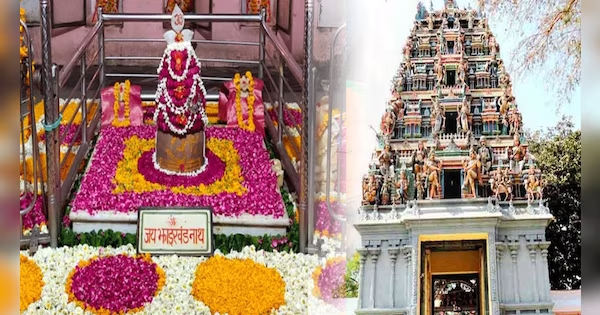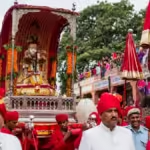Jharkhand Mahadev Holy Place in Jaipur: A Spiritual Oasis of Serenity and Dedication
Nestled in the bustling cityscape of Jaipur, the Jharkhand Mahadev Holy Place stands as a serene sanctuary of spirituality and devotion. This revered temple, dedicated to Lord Shiva, is not just a place of worship but also a testament to the rich cultural and architectural heritage of Rajasthan. The temple’s tranquil ambiance, coupled with its historical and religious significance, makes it a must-visit destination for devotees and tourists alike. In this article, we delve into the history, architecture, rituals, and cultural importance of the Jharkhand Mahadev Temple, providing a comprehensive understanding of this sacred abode.
Historical Background
The Jharkhand Mahadev Holy Place has a rich history that dates back several centuries. It is believed to have been established during the reign of the Rajput kings, who were ardent followers of Lord Shiva. The temple’s name, “Jharkhand,” is derived from the Sanskrit words “Jhar” (waterfall) and “Khand” (land), indicating the presence of a natural water source in the vicinity. The temple’s location was chosen for its spiritual significance, as the area was believed to be blessed with divine energy. Over the years, the temple has undergone several renovations, preserving its original charm while incorporating new architectural elements.
Architectural Splendor
The architecture of the Jharkhand Mahadev Temple is a harmonious blend of traditional Rajasthani and Mughal styles. The temple’s main entrance is adorned with intricate carvings and sculptures depicting various Hindu deities and mythological scenes. The sanctum sanctorum houses a majestic Shiva Lingam, the symbol of Lord Shiva’s cosmic power and presence. The temple’s interiors are embellished with beautiful frescoes and murals, showcasing episodes from Hindu mythology.
One of the most striking features of the temple is its towering shikhara (spire), which is intricately carved with motifs of lotus flowers, peacocks, and celestial beings. The shikhara is crowned with a golden kalash (pot), symbolizing abundance and prosperity. The temple complex also includes smaller shrines dedicated to other deities, such as Goddess Parvati, Lord Ganesha, and Lord Kartikeya, making it a comprehensive spiritual center for devotees.
Spiritual Significance
The Jharkhand Mahadev Holy Place holds immense spiritual significance for the followers of Lord Shiva. It is believed that offering prayers at this temple can cleanse one’s soul, remove obstacles, and grant blessings for a prosperous life. The temple is especially revered during the auspicious month of Shravan (July-August), which is dedicated to Lord Shiva. During this time, devotees observe fasts, perform rituals, and participate in special prayers and ceremonies.
One of the unique aspects of the temple is its natural water source, which is considered sacred. Devotees often take a ritual bath in the holy water before entering the temple premises, as it is believed to purify the body and soul. The temple also hosts various religious festivals and events throughout the year, including Maha Shivaratri, Kartik Purnima, and Navratri, attracting a large number of devotees from different parts of the country.
Rituals and Worship
The daily rituals at the Jharkhand Mahadev Temple are performed with great devotion and reverence. The temple opens early in the morning, and the day begins with the “Mangal Aarti,” a prayer ritual conducted to invoke the blessings of Lord Shiva. The aarti is accompanied by the chanting of Vedic hymns and the melodious sounds of bells and conch shells, creating a spiritually uplifting atmosphere.
Throughout the day, devotees offer prayers, light incense sticks, and present flowers, fruits, and sweets to the deity. The “Rudrabhishek,” a special ritual involving the anointment of the Shiva Lingam with water, milk, honey, and other sacred substances, is a significant aspect of the temple’s worship. This ritual is believed to please Lord Shiva and grant his divine blessings.
In the evening, the temple conducts the “Sandhya Aarti,” a ritual that marks the end of the day’s worship. The aarti is a beautiful and serene experience, with the temple premises illuminated by oil lamps and the air filled with devotional songs and prayers. The temple also has a designated area for meditation and spiritual practices, providing a peaceful space for devotees to connect with the divine.
Cultural and Social Impact
The Jharkhand Mahadev Temple is not only a place of worship but also a cultural hub that promotes the rich traditions of Rajasthan. The temple organizes various cultural programs, religious discourses, and community services, fostering a sense of unity and harmony among the devotees. The temple’s management is actively involved in charitable activities, including providing food and medical aid to the underprivileged, supporting educational initiatives, and organizing blood donation camps.
The temple also plays a crucial role in preserving and promoting traditional art forms, such as classical music, dance, and folk arts. During festivals and special occasions, the temple premises come alive with performances by local artists, showcasing the vibrant cultural heritage of the region. These events not only provide a platform for artists to showcase their talent but also offer an opportunity for visitors to experience the rich cultural tapestry of Rajasthan.
Visitor Experience
Visiting the Jharkhand Mahadev Temple is a spiritually enriching experience that leaves a lasting impression on the hearts of devotees and tourists. The temple’s serene ambiance, coupled with its architectural grandeur and spiritual significance, makes it a must-visit destination in Jaipur. The temple is well-maintained, and the staff is courteous and helpful, ensuring a comfortable and memorable visit for everyone.
For those seeking solace and a deeper connection with the divine, the temple offers various spiritual activities, including meditation sessions, yoga classes, and religious discourses. The temple’s natural surroundings, with lush greenery and a tranquil water source, provide a perfect setting for introspection and spiritual rejuvenation.
Conclusion
The Jharkhand Mahadev Temple in Jaipur is a spiritual refuge that embodies the essence of devotion, spirituality, and cultural heritage. It stands as a beacon of faith, attracting countless devotees who seek the blessings of Lord Shiva. Whether you are a devout follower or a curious traveler, a visit to this temple offers a unique opportunity to experience the rich traditions and spiritual aura of Rajasthan.
With its rich history, architectural splendor, and spiritual significance, the Jharkhand Mahadev Temple continues to inspire and uplift the hearts of all who visit. It is a place where the divine and the mortal realms converge, offering a glimpse into the eternal and the infinite. So, if you find yourself in Jaipur, make sure to visit the Jharkhand Mahadev Temple and immerse yourself in its divine grace and serenity.
For more information on Rajasthan Tour Packages, explore our website and plan your journey to experience the spiritual and cultural richness of Rajasthan.
Quation and Answer on Jharkhand Mahadev Temple
Quation: 1. What is the importance of the Jharkhand Mahadev Holy Place in Jaipur?
Answer: The Jharkhand Mahadev Temple is substantial for its deep spiritual and social heritage. Committed to Lord Shiva, it works as a serene sanctuary amidst Jaipur’s bustling cityscape. The holy place’s historical origins trace back to the Rajput period, showing the abundant cultural and architectural customs of Rajasthan. It is additionally renowned for its spiritual natural water source, which devotees believe to detoxify the spirit.
Quation: 2. What historic history is associated with the Jharkhand Mahadev Holy Place?
Answer: The Jharkhand Mahadev Holy place is believed to have actually been established throughout the reign of the Rajput kings, that were devoted followers of Lord Shiva. The name “Jharkhand” converts to “land of waterfalls,” showing the existence of an all-natural water source around the temple. Over the centuries, the temple has actually gone through several remodellings, maintaining its original appeal while integrating brand-new building aspects.
Quation: 3. How would you describe the architectural style of the Jharkhand Mahadev Holy Place?
Answer: The temple features a mix of conventional Rajasthani and Mughal building styles. The primary entry is embellished with intricate makings and sculptures of Hindu deities and mythical scenes. The sanctum sanctorum houses a popular Shiva Lingam, and the towering shikhara (apex) is elaborately sculpted with concepts such as lotus blossoms and peacocks. The holy place complicated also includes smaller sized shrines committed to various other divine beings like Parvati and Ganesha.
Quation: 4. What is the spiritual value of the Jharkhand Mahadev Temple?
Answer: The holy place holds immense spiritual worth for followers of Lord Shiva. It is thought that petitions used here can cleanse the soul, remove challenges, and present true blessings for a flourishing life. The holy place’s all-natural water source is thought about sacred, with fans taking ritual bathrooms in it prior to going into the temple. Unique importance is put on the month of Shravan and festivals like Maha Shivaratri, when the holy place attracts several worshippers.
Quation: 5. What are a few of the crucial routines performed at the Jharkhand Mahadev Holy Place?
Answer: Secret routines at the holy place consist of the “Mangal Aarti” executed in the early morning to conjure up Lord Shiva’s blessings, and the “Rudrabhishek,” where the Shiva Lingam is blessed with sacred products like water, milk, and honey. The night “Sandhya Aarti” marks the end of the day’s prayers with a calm ambience produced by oil lights and religious music. The holy place additionally supplies rooms for reflection and spiritual practices.
Quation: 6. How does the Jharkhand Mahadev Temple contribute to the social life of Jaipur?
Answer: The holy place works as a social hub, organizing numerous programs that promote Rajasthan’s standard arts. It organizes spiritual discussions, classical music and dance efficiencies, and folk art events. The temple’s involvement in philanthropic tasks, such as offering food and clinical help, more enriches its role in the community, protecting and showcasing the lively social heritage of the region.
Quation: 7. What can visitors anticipate during their browse through to the Jharkhand Mahadev Temple?
Answer: Site visitors can anticipate a spiritually uplifting experience defined by the temple’s tranquil setting and building charm. The well-kept premises and considerate personnel ensure a comfortable check out. Spiritual tasks such as meditation sessions and yoga exercise classes are offered for those seeking a deeper connection with the divine. The rich environments and all-natural water source provide a serene setup for representation.
Quation: 8. Why should vacationers include the Jharkhand Mahadev Temple in their travel plan when going to Jaipur?
Answer: Vacationers need to consist of the Jharkhand Mahadev Holy place in their travel plan to experience a distinct blend of spirituality, culture, and building grandeur. The holy place’s rich background and peaceful ambience supply a reprieve from the city’s hustle and bustle. Its function as a social and spiritual center makes it a must-visit location for those curious about checking out the much deeper customs and heritage of Rajasthan.



